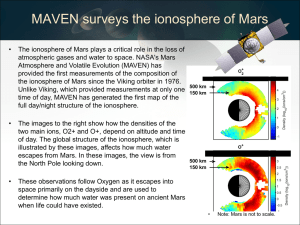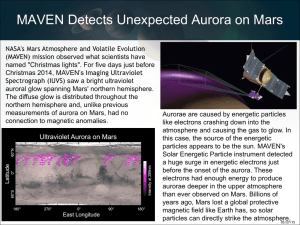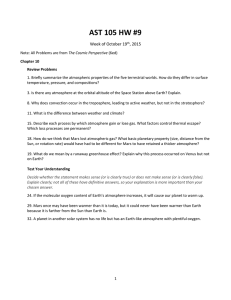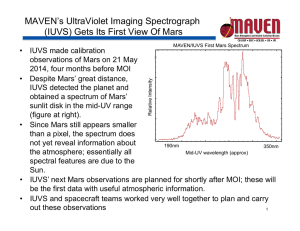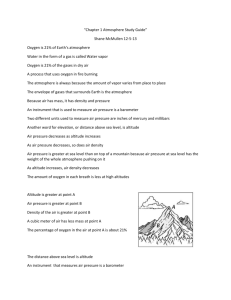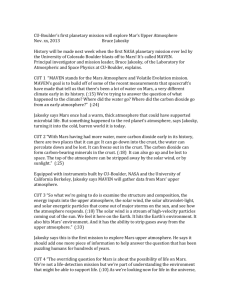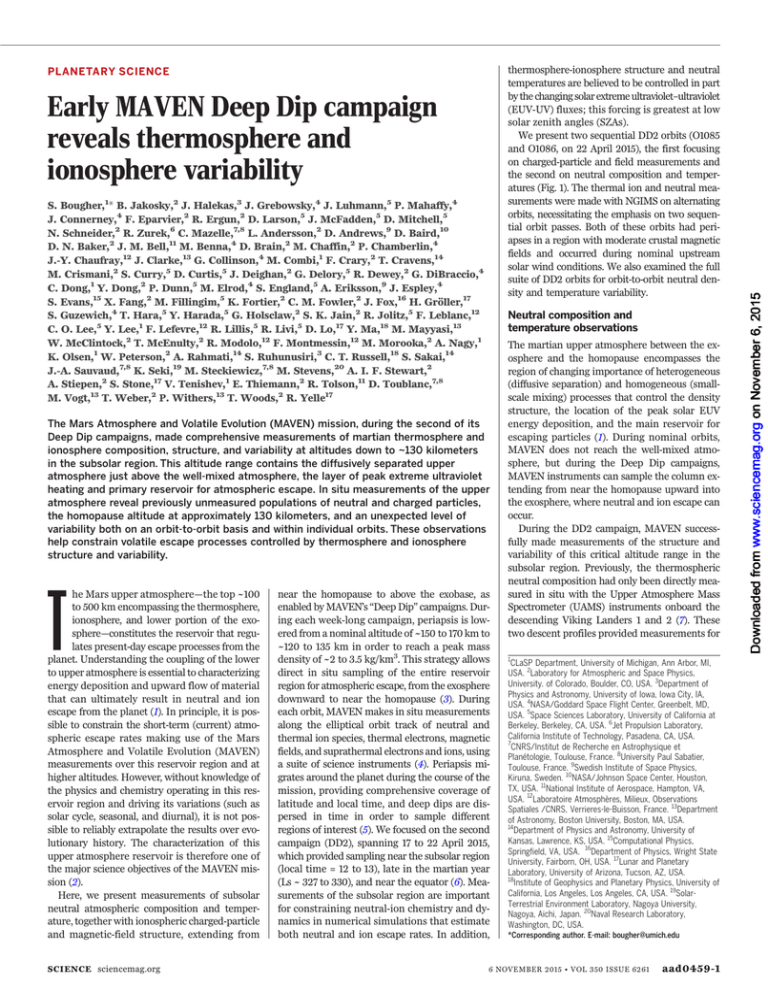
Early MAVEN Deep Dip campaign
reveals thermosphere and
ionosphere variability
S. Bougher,1* B. Jakosky,2 J. Halekas,3 J. Grebowsky,4 J. Luhmann,5 P. Mahaffy,4
J. Connerney,4 F. Eparvier,2 R. Ergun,2 D. Larson,5 J. McFadden,5 D. Mitchell,5
N. Schneider,2 R. Zurek,6 C. Mazelle,7,8 L. Andersson,2 D. Andrews,9 D. Baird,10
D. N. Baker,2 J. M. Bell,11 M. Benna,4 D. Brain,2 M. Chaffin,2 P. Chamberlin,4
J.-Y. Chaufray,12 J. Clarke,13 G. Collinson,4 M. Combi,1 F. Crary,2 T. Cravens,14
M. Crismani,2 S. Curry,5 D. Curtis,5 J. Deighan,2 G. Delory,5 R. Dewey,2 G. DiBraccio,4
C. Dong,1 Y. Dong,2 P. Dunn,5 M. Elrod,4 S. England,5 A. Eriksson,9 J. Espley,4
S. Evans,15 X. Fang,2 M. Fillingim,5 K. Fortier,2 C. M. Fowler,2 J. Fox,16 H. Gröller,17
S. Guzewich,4 T. Hara,5 Y. Harada,5 G. Holsclaw,2 S. K. Jain,2 R. Jolitz,5 F. Leblanc,12
C. O. Lee,5 Y. Lee,1 F. Lefevre,12 R. Lillis,5 R. Livi,5 D. Lo,17 Y. Ma,18 M. Mayyasi,13
W. McClintock,2 T. McEnulty,2 R. Modolo,12 F. Montmessin,12 M. Morooka,2 A. Nagy,1
K. Olsen,1 W. Peterson,2 A. Rahmati,14 S. Ruhunusiri,3 C. T. Russell,18 S. Sakai,14
J.-A. Sauvaud,7,8 K. Seki,19 M. Steckiewicz,7,8 M. Stevens,20 A. I. F. Stewart,2
A. Stiepen,2 S. Stone,17 V. Tenishev,1 E. Thiemann,2 R. Tolson,11 D. Toublanc,7,8
M. Vogt,13 T. Weber,2 P. Withers,13 T. Woods,2 R. Yelle17
Neutral composition and
temperature observations
The Mars Atmosphere and Volatile Evolution (MAVEN) mission, during the second of its
Deep Dip campaigns, made comprehensive measurements of martian thermosphere and
ionosphere composition, structure, and variability at altitudes down to ~130 kilometers
in the subsolar region. This altitude range contains the diffusively separated upper
atmosphere just above the well-mixed atmosphere, the layer of peak extreme ultraviolet
heating and primary reservoir for atmospheric escape. In situ measurements of the upper
atmosphere reveal previously unmeasured populations of neutral and charged particles,
the homopause altitude at approximately 130 kilometers, and an unexpected level of
variability both on an orbit-to-orbit basis and within individual orbits. These observations
help constrain volatile escape processes controlled by thermosphere and ionosphere
structure and variability.
T
he Mars upper atmosphere—the top ~100
to 500 km encompassing the thermosphere,
ionosphere, and lower portion of the exosphere—constitutes the reservoir that regulates present-day escape processes from the
planet. Understanding the coupling of the lower
to upper atmosphere is essential to characterizing
energy deposition and upward flow of material
that can ultimately result in neutral and ion
escape from the planet (1). In principle, it is possible to constrain the short-term (current) atmospheric escape rates making use of the Mars
Atmosphere and Volatile Evolution (MAVEN)
measurements over this reservoir region and at
higher altitudes. However, without knowledge of
the physics and chemistry operating in this reservoir region and driving its variations (such as
solar cycle, seasonal, and diurnal), it is not possible to reliably extrapolate the results over evolutionary history. The characterization of this
upper atmosphere reservoir is therefore one of
the major science objectives of the MAVEN mission (2).
Here, we present measurements of subsolar
neutral atmospheric composition and temperature, together with ionospheric charged-particle
and magnetic-field structure, extending from
SCIENCE sciencemag.org
near the homopause to above the exobase, as
enabled by MAVEN’s “Deep Dip” campaigns. During each week-long campaign, periapsis is lowered from a nominal altitude of ~150 to 170 km to
~120 to 135 km in order to reach a peak mass
density of ~2 to 3.5 kg/km3. This strategy allows
direct in situ sampling of the entire reservoir
region for atmospheric escape, from the exosphere
downward to near the homopause (3). During
each orbit, MAVEN makes in situ measurements
along the elliptical orbit track of neutral and
thermal ion species, thermal electrons, magnetic
fields, and suprathermal electrons and ions, using
a suite of science instruments (4). Periapsis migrates around the planet during the course of the
mission, providing comprehensive coverage of
latitude and local time, and deep dips are dispersed in time in order to sample different
regions of interest (5). We focused on the second
campaign (DD2), spanning 17 to 22 April 2015,
which provided sampling near the subsolar region
(local time = 12 to 13), late in the martian year
(Ls ~ 327 to 330), and near the equator (6). Measurements of the subsolar region are important
for constraining neutral-ion chemistry and dynamics in numerical simulations that estimate
both neutral and ion escape rates. In addition,
The martian upper atmosphere between the exosphere and the homopause encompasses the
region of changing importance of heterogeneous
(diffusive separation) and homogeneous (smallscale mixing) processes that control the density
structure, the location of the peak solar EUV
energy deposition, and the main reservoir for
escaping particles (1). During nominal orbits,
MAVEN does not reach the well-mixed atmosphere, but during the Deep Dip campaigns,
MAVEN instruments can sample the column extending from near the homopause upward into
the exosphere, where neutral and ion escape can
occur.
During the DD2 campaign, MAVEN successfully made measurements of the structure and
variability of this critical altitude range in the
subsolar region. Previously, the thermospheric
neutral composition had only been directly measured in situ with the Upper Atmosphere Mass
Spectrometer (UAMS) instruments onboard the
descending Viking Landers 1 and 2 (7). These
two descent profiles provided measurements for
1
CLaSP Department, University of Michigan, Ann Arbor, MI,
USA. 2Laboratory for Atmospheric and Space Physics,
University. of Colorado, Boulder, CO, USA. 3Department of
Physics and Astronomy, University of Iowa, Iowa City, IA,
USA. 4NASA/Goddard Space Flight Center, Greenbelt, MD,
USA. 5Space Sciences Laboratory, University of California at
Berkeley, Berkeley, CA, USA. 6Jet Propulsion Laboratory,
California Institute of Technology, Pasadena, CA, USA.
7
CNRS/Institut de Recherche en Astrophysique et
Planétologie, Toulouse, France. 8University Paul Sabatier,
Toulouse, France. 9Swedish Institute of Space Physics,
Kiruna, Sweden. 10NASA/Johnson Space Center, Houston,
TX, USA. 11National Institute of Aerospace, Hampton, VA,
USA. 12Laboratoire Atmosphères, Milieux, Observations
Spatiales /CNRS, Verrieres-le-Buisson, France. 13Department
of Astronomy, Boston University, Boston, MA, USA.
14
Department of Physics and Astronomy, University of
Kansas, Lawrence, KS, USA. 15Computational Physics,
Springfield, VA, USA. 16Department of Physics, Wright State
University, Fairborn, OH, USA. 17Lunar and Planetary
Laboratory, University of Arizona, Tucson, AZ, USA.
18
Institute of Geophysics and Planetary Physics, University of
California, Los Angeles, Los Angeles, CA, USA. 19SolarTerrestrial Environment Laboratory, Nagoya University,
Nagoya, Aichi, Japan. 20Naval Research Laboratory,
Washington, DC, USA.
*Corresponding author. E-mail: bougher@umich.edu
6 NOVEMBER 2015 • VOL 350 ISSUE 6261
aad0459-1
Downloaded from www.sciencemag.org on November 6, 2015
thermosphere-ionosphere structure and neutral
temperatures are believed to be controlled in part
by the changing solar extreme ultraviolet–ultraviolet
(EUV-UV) fluxes; this forcing is greatest at low
solar zenith angles (SZAs).
We present two sequential DD2 orbits (O1085
and O1086, on 22 April 2015), the first focusing
on charged-particle and field measurements and
the second on neutral composition and temperatures (Fig. 1). The thermal ion and neutral measurements were made with NGIMS on alternating
orbits, necessitating the emphasis on two sequential orbit passes. Both of these orbits had periapses in a region with moderate crustal magnetic
fields and occurred during nominal upstream
solar wind conditions. We also examined the full
suite of DD2 orbits for orbit-to-orbit neutral density and temperature variability.
PLANETARY SCIENCE
M A VE N G O ES TO MA R S
SZA near 44° at low-to-middle latitude for two
afternoon locations during solar minimum and
near aphelion conditions. The total mass density
of the Mars thermosphere has also been measured
by several spacecraft accelerometers (5, 8, 9).
The MAVEN NGIMS instrument measures the
neutral composition of the major gas species (such
as He, N, O, CO, N2, O2, NO, Ar, and CO2) and
their major isotopes, with a vertical resolution of
~5 km for targeted species and a target accuracy
of <25% for most of these species (10). Corresponding temperatures can be derived from the
neutral-scale heights. These multispecies measurements are obtained along an orbit trajectory
that combines both vertical and horizontal variations of the upper atmosphere structure (1).
These convolved variations cannot be separated
without the use of numerical models.
Four key neutral species are presented (CO2,
Ar, N2, and O) for the inbound leg (Fig. 2). The
NGIMS and Mars Global Ionosphere-Thermosphere Model (M-GITM)–simulated CO2, N2, and
Ar density profiles match reasonably well throughout the altitude range (supplementary text S1)
(9). For example, in the range of 160 to 220 km,
M-GITM diurnal variations of CO2 encompass
NGIMS densities quite well, whereas below 160 km,
M-GITM underestimates NGIMS CO2 densities
(up to a factor of ~2 at 130 km). Both models and
observations show an exponential variation of
density with altitude. The scale heights of these
species are different at higher altitudes, with most
of them (CO2, Ar, and N2) showing a common
scale height as 130 km is approached. This is
consistent with a homopause near 130 km, but
quantitative confirmation of the precise homopause altitude cannot be seen in this figure. Atomic O scale heights do not follow this pattern of
transitioning scale heights because local chemical
production and loss processes are important (3).
These multispecies, subsolar, neutral-atmosphere
measurements capture near-homopause (~130 km)
to exosphere (above ~200 km) structure together
on the same orbit.
The atomic O density profiles from NGIMS (Fig.
2) constrain the ion-neutral chemistry, thermal
heat budget, and dynamics of the Mars dayside
upper atmosphere (1). NGIMS-measured O densities have been corrected for (i) open-source
neutral beaming (OSNB) retrieval, (ii) contributions from CO2 at lower altitudes, and (iii) “pile
up” RAM direction enhancement of densities when
approaching periapsis altitudes, with largest corrections present for the higher densities during
Deep Dip orbits. Atomic O densities are determined to be reliable (within the ~25% error)
down to ~150 km. Comparison of measured and
simulated DD2 atomic O profiles shows reasonable agreement at all altitudes, with densities at
~200 km close to ~5.0 × 107 to 6.0 × 107 cm−3.
These NGIMS-measured O densities are nearly a
factor of ~5 larger than corresponding Mars Express (MEx)/Spectroscopy for Investigation of Characteristics of the Atmosphere of Mars (SPICAM)
estimates derived via remote sensing (11). The differences in the seasonal (equinox versus aphelion)
and solar cycle (solar moderate versus minimum)
aad0459-2
Fig. 1. MAVEN Deep Dip 2 orbital geometry. MAVEN spacecraft “along-track” latitude versus local
time coverage of DD2 sampling below 500 km is illustrated (NGIMS measurements are limited to this
altitude range). Beginning (O1060) and ending (O1086) orbit information is provided, capturing both
inbound and outbound legs, plus the periapsis location (triangles). The 500 and 300 km points on each
leg are also delineated by black tick marks. The start of each inbound leg is identified (yellow dots).
Specific orbits selected for detailed investigation (O1085 and O1086) fall in between these bounding
orbits. SZA is also indicated along these orbit trajectories.
240
220
200
180
160
140
105
106
107
108
109
1010
1011
Fig. 2. Neutral density environment near periapsis during the subsolar DD2 campaign. These
altitude profiles are provided over ~130 to 250 km specifically for a single orbit (O1086) from 22 April
2015 (supplementary text S2). Four key neutral species are plotted (CO2, Ar, N2, and O) for the inbound
leg (hashed curves). Simulated subsolar density profiles from the M-GITM, calculated at the location of
the spacecraft along its orbit for the solar moderate case (Equinox), are overplotted (solid curves) for
comparison (supplementary text S1). The plotted NGIMS densities have been processed by using a 20-s
polynomial time-averaging technique so as to remove high-frequency, small-scale variations (supplementary text S3). Calculated NGIMS error bars are included in each profile (supplementary text S4). In
addition, 1-[s] variance bars are added to the 1-SOL averaged M-GITM CO2 densities in order to illustrate
their expected diurnal variation.
6 NOVEMBER 2015 • VOL 350 ISSUE 6261
sciencemag.org SCIENCE
sampling between these two data sets may be
responsible for this factor of ~5 variation. This substantial variation in atomic O densities at 200 km
may have important implications for mass loading of the solar wind because thermospheric and
exospheric O densities are simulated to respond
similarly to solar cycle and seasonal changes (12).
The O/CO2 ratio is expected to vary with the
changing solar EUV-UV fluxes reaching Mars
(affecting CO2 photolysis rates) and the ability
of the thermospheric circulation to transport
atomic O around the planet (1). A data-model
comparison shows that the altitude at which
this ratio is unity occurs around ~225 km for
both NGIMS and M-GITM profiles near the
subsolar region (Fig. 3A). This profile determines
that the O abundance becomes important above
225 km in the Mars exosphere. This cold O constraint is important for making proper calculations
of hot O escape (1). Similarly, this O/CO2 ratio
near 150 km (about ~20 km above the expected
primary ion peak) is measured to be ~4.0% and is
consistent with the NGIMS-measured O2+/CO2+ ratio
of ~6.0 at the same altitude. This occurs because
this ion ratio is directly controlled by the atomic
O abundance (13).
As the measured N2 and CO2 profiles approach
~130 km, the N2/CO2 ratio converges on the bulk
atmosphere value of ~2.0% (Fig. 3B), recently
measured by the Mars Science Laboratory (MSL)
Sample Analysis at Mars Suite (SAMS) instrument
(14). The decrease of the ratio with decreasing
height is expected because the N2 scale height
is larger than that for CO2. The convergence of
this NGIMS N2/CO2 ratio to the constant value
of ~2.0% near 130 km indicates that the N2
homopause altitude during this orbit is located
at ~130 km. In fact, all species are subject to the
same small-scale mixing, but each has a slightly different homopause altitude owing to small
variations in molecular diffusion coefficients (3).
By this same method, the simulated M-GITM
N2/CO2 ratio places the N2 homopause at ~120 km
altitude. The difference between these two homopause altitudes implies that some refinement of
the small-scale mixing (eddy diffusion) is needed
in the M-GITM code (supplementary text S1) (9).
This model adjustment is expected because the
homopause altitude is very sensitive to small-scale
mixing, which is itself poorly constrained other
than by these new MAVEN measurements. In
addition, M-GITM assumes the Viking mixedatmosphere value of the N2/CO2 ratio (~2.7%) (7),
which is larger than measured by SAMS (14).
These NGIMS density profiles provide an important initial determination of the dayside homopause altitude, which was previously estimated
from Viking modeling studies to be located between ~120 and 130 km (7).
Derived NGIMS and simulated M-GITM average temperature profiles (over the entire DD2
campaign) each include averaging over longitude
and various wave features (Fig. 4). These averaged NGIMS temperature profiles are constructed
by using the Snowden method with hydrostatic
integration over the DD2 averaged Ar and N2
density profiles (15). Such averaging serves to
SCIENCE sciencemag.org
smooth out much of the wave structure and determines that the upper-boundary temperature
gradients should be close to zero (isothermal).
For M-GITM, simulated temperatures are extracted along each orbit trajectory and subsequently averaged together over all DD2 orbits. The
Fig. 3. Altitude plots
illustrating key neutral density ratios
below 300 km for
DD2. These ratios
(Top) O/CO2 and
(Bottom) N2/CO2 are
composed of the same
O1086 NGIMS and
M-GITM density profiles
illustrated in Fig. 2. The
O/CO2 = 1 crossover
point near ~225 km (for
both NGIMS and
M-GITM) is indicated
with a vertical dashed
line. The measured
N2/CO2 MSL mixedatmosphere value of
~2.0% is also indicated
with a vertical dashed
line (14).
Fig. 4. Profiles of averaged temperature profiles from the entire DD2 campaign. Both NGIMS
derived (N2 and Ar) and M-GITM–simulated temperature profiles are plotted up to 250 km. Mean
exospheric temperatures (200 to 250 km) approach ~268 K (NGIMS) and ~257 K (M-GITM).
6 NOVEMBER 2015 • VOL 350 ISSUE 6261
aad0459-3
M A VE N G O ES TO MA R S
observed large vertical temperature gradient
over ~140 to 170 km coincides with the peak layer
of EUV heating, whereas the topside temperatures
approach isothermal values above ~200 km. In
particular, exospheric temperatures (Texo) are separately extracted from Ar densities by averaging
temperatures over ~200 to 250 km for each orbit,
then averaging all orbit values together. CO2 and
N2 densities could also be used, yielding similar
temperatures (16). The resulting NGIMS extracted
mean Texo value of ~268 K is compared with the
simulated mean value of ~257 K from M-GITM.
This MAVEN dayside temperature profile is
the result of averaging over several DD2 orbits
and consequently masks the significant orbit-toorbit (1s) variability of NGIMS exospheric temperatures (268 ± 19 K) (16). This temporal behavior is similar to that observed from MEx
dayside measurements (~270 ± 25 K) extracted
from SPICAM dayglow scale heights over 2004–
2009 (17, 18). Furthermore, M-GITM simulations
(primarily solar-driven) cannot capture this orbitto-orbit variability, yet M-GITM simulations can
reasonably match the DD2 orbit mean Texo value.
This large orbit-to-orbit variability implies that
dayside thermospheric temperatures are not controlled exclusively by solar EUV forcing, as models
might predict (17, 18).
Repeated MAVEN sampling at the 200-km
level provides another method for characterization of upper-atmosphere variability near the base
of the exosphere. NGIMS neutral densities show a
substantial orbit-to-orbit variability throughout the
DD2 campaign. Altitude profiles of O and CO2
densities spanning 14 orbits from O1060 to O1086
show substantial variability on ~4- to 5-hour time
scales (Fig. 5). The altitude at which the O/CO2
ratio crosses through unity varies from ~225 to
238 km for these orbits. The O and CO2 variations
at a constant altitude are also substantial, with
measured O densities at 200 km ranging from
~5.0 × 107 to ~1.0 × 108 cm−3 (factor of 2), whereas
CO2 densities vary from ~1.3 × 108 to ~3.5 × 108 cm−3
(factor of 2.7). These density variations are notable,
especially when combined with exospheric temperature variations described above. The implication is that upper-atmosphere structure near
200 km varies substantially from orbit to orbit
(on at least ~5-hour time scales), and also as a
function of season and solar cycle as illustrated
by MEx versus MAVEN results. Orbit-to-orbit variability may be driven from below owing to gravity
wave interactions with the global wind structure
and small-scale mixing processes (19, 20). This
combined density and temperature variability at
this exobase altitude (21) ultimately has a direct
impact upon volatile escape rates (1).
Charged-particle and magneticfield observations
Plasma measurements extending from the magnetosphere down to the main peak of the subsolar martian ionosphere have been collected by
MAVEN. MGS and MEx previously explored the
induced magnetosphere and the transition to the
upper ionosphere (22, 23), but neither mission
carried a complete complement of plasma instruaad0459-4
240
220
200
180
160
106
107
108
109
1010
Fig. 5. Altitude plots of O and CO2 densities over 150 to 250 km. NGIMS O (dashed lines) and CO2
(solid lines) density profiles are plotted throughout the DD2 campaign, spanning 14 orbits from O1060 to
O1086. Separate profiles are color-coded for orbit identification. The black dots for each orbit correspond
to the crossing point at which the O/CO2 ratio is unity. These altitudes range from ~225 to 238 km. The
mean height is 230.5 T 2.5 km.
mentation. Meanwhile, characterization of the
lower-altitude collisional ionosphere has primarily used remote sounding techniques (24, 25), revealing variable structure (26) and only occasionally
a Venus-like ionopause (27). Viking provided the
only previous direct measurements of lower ionospheric structure and composition (13), but only
in a narrow range of SZA.
Measurements from MAG (28), SWEA (2),
SWIA (29), LPW (30), and NGIMS (10) reveal
the complex morphology of the inner magnetosphere and ionosphere (Figs. 6 and 7). Periapsis
for this orbit (O1085) occurred at 48°W, 6°S, in a
region with moderate crustal magnetic fields, at
an altitude of ~130 km and SZA of ~5°. During
this period, the spacecraft remained below the
induced magnetospheric boundary until 02:18
UTC, after which MAVEN observed suprathermal particles characteristic of the magnetosheath.
Before 02:18 UTC, electron spectra displayed features characteristic of atmospheric photoelectrons
throughout. Outside of the main peak of the ionosphere (before 02:02 and after 02:12 UTC), in
the transport-dominated regime (above ~200 km,
major ion lifetimes are >~600 s), charged-particle
populations and magnetic fields show substantial
structure, likely consisting of a mix of transient
variations and horizontal and/or vertical structure.
O+ and O2+ dominate the thermal ion composition, with both varying over orders of magnitude,
particularly on the outbound pass. The draped
magnetic-field rotations, compositional changes,
6 NOVEMBER 2015 • VOL 350 ISSUE 6261
and electron temperature changes associated with
the ion density layers at L3 and L4 and the intervening density depletions suggest that these
represent primarily temporal variations, implying rapid ionospheric reconfigurations, indicative
of substantial transport and/or strong compressional waves.
At times L1 and L2, the spacecraft passed
sharp thermal ion density layers (more pronounced on the inbound segment). At the same
locations, MAVEN observed the signatures of
localized currents, visible as a discontinuity in
the magnetic field [and a rotation toward a
more horizontal field below the layers (Fig. 7)].
These features occurred just above a transition
to a smoothly varying photoelectron population,
which is consistent with the collisional photochemically controlled region of the ionosphere
(31). This ion layer may represent the topside
layer previously seen in radar (32) and radio
sounding (33) by MEx [perhaps also in the Viking-2
descent (13)] but appears narrower (~5 to 10 km)
than is apparent from remote measurements.
The sharpness of the layer in comparison with
expected variations in neutral density and EUV
energy deposition implies vertical transport and
suggests that it could represent a transition between a region dominated by draped and/or induced magnetic fields and one dominated by
crustal fields (33, 34). Localized electric fields
could also play a role, as previously observed at
Earth (35). The sharp drop in electron temperature
sciencemag.org SCIENCE
Fig. 6. Plasma environment near periapsis during the subsolar DD2 campaign. These time series
plots are provided over 130 to 500 km in a region with moderate crustal fields, during a time period with
quiet solar wind conditions, and specifically for O1085 (22 April 2015). (A) MAG-measured (solid) and
spherical harmonic model (dashed) crustal magnetic-field vector components (Bx, By, and Bz) in MarsSolar-Orbital coordinates. (B) SWEA energy spectra of suprathermal electrons. (C) SWIA energy spectra
of downward-going suprathermal ions. (D) NGIMS abundances of major ion species (O+, O2+, CO2+, and
NO+). (E) Spacecraft altitude plus LPW electron temperatures (dashed lines indicate upper and lower
bounds, with the solid lines showing the best-fit value). Mars-Solar-Orbital latitude (MSO Lat), solar
zenith angle (SZA), and universal time coordinated hour and minute (hhmm) are also provided along the
time series below 500 km. Labeled vertical dashed lines are provided to highlight features discussed in
the text, including localized ion layers (L1 to L4), peaks in CO2+ density (C1 and C2), and periapsis (P),
which occurs at 02:07 UTC, at a SZA of ~5°.
below this layer also indicates a topological boundary that locally affects photoelectron transport
and suggests that photochemical processes play
a role (36).
At lower altitudes, O+ densities drop rapidly
owing to reactions with neutral molecules, but
suprathermal photoelectrons and thermal CO2+
ions continue to increase in density (with very
similar altitude dependence, commensurate with
their production primarily from neutral CO2).
These populations peak at the times marked C1
and C2—at altitudes of ~140 km, below which
SCIENCE sciencemag.org
they decrease—presumably because of recombination and reactions with neutral species. CO2+ densities peak at a higher altitude than that of O2+
densities, and higher than observed at higher SZA
by Viking (13). Meanwhile, O2+ densities continue
to increase until just above periapsis (time P). The
slight decrease in density at periapsis may indicate that the spacecraft reached the main M2
peak of the ionosphere, which is consistent with
the periapsis altitude.
The different altitude profiles for major ion
species and photoelectrons reflect the variations
in source and loss processes as a function of altitude, stemming from the varying deposition of
EUV and other energy inputs (comprehensively
measured by MAVEN), changes in neutral composition, and the steeply increasing neutral density. Multifluid magnetohydrodynamic (MHD)
model results capture some, but not all, of the observed variations in ion abundance along the orbit
track (supplementary text S5) (37, 38). The model
correctly reproduces the structure of the dominant O2+ ions at altitudes below ~220 km and
also captures the structure of the CO2+ ions over
most of this altitude range. Above ~220 km, in
the transport-dominated region, the time-stationary
model results cannot adequately capture the
transient dynamics. The model also underestimates O+ density everywhere except periapsis
and does not capture the turnover in the CO2+
density at low altitudes.
All the major ion species show substantial wave
structure on the outbound segment (but not on
the inbound), extending almost down to periapsis.
This wave structure correlates closely (although
not one-to-one everywhere) with fluctuations seen
in the neutral density at the same time, suggesting
that many of the observed neutral and ion fluctuations might have a common origin, presumably gravity waves (19, 20).
Suprathermal ion measurements provide another probe of collisional processes in the atmosphere. A downward-going population of ~1 keV
ions appears between L1 and L2. These ions
represent the products of hydrogen energetic
neutral atoms (ENAs) produced through charge
exchange between solar wind protons and exospheric atoms in the distant corona outside of
the bow shock (39, 40). In neutral form, these
particles pass through the magnetosphere unaffected by electromagnetic form, maintaining
the same velocity as that of the solar wind. Upon
encountering the atmosphere, some of the ENAs
undergo charge-stripping reactions and regain
their charge, allowing MAVEN to measure them.
As the neutral density rises, these particles lose
energy through numerous collisions with atmospheric gases. The ratio of electron-stripping to
charge-exchange cross sections decreases sharply
at lower energies, leading to a decrease in the
charged fraction of the precipitating hydrogen
between C1 and C2. These penetrating solar wind
particles represent an additional source of energy to the upper atmosphere, with a different
deposition profile from that of EUV. They also
provide a proxy measurement of the solar wind,
allowing us to infer an upstream solar wind speed
of ~500 km/s and density of ~1.1 cm−3 (40).
At higher energies of ~10 to 20 keV, SWIA
observes an additional population of precipitating ions, which penetrate well into the photochemical region of the atmosphere (below the “exobase”).
When this population extends to higher altitudes, at which suprathermal ion composition
measurements in this energy range from STATIC
(2) are available, they indicate predominantly O+,
which is consistent with pickup ions produced
by photoionization and charge-transfer reactions
in the upstream corona. These precipitating ions
6 NOVEMBER 2015 • VOL 350 ISSUE 6261
aad0459-5
M A VE N G O ES TO MA R S
Fig. 7. Altitude plots of ion densities and other plasma fields over 130 to 300 km. NGIMS ion
densities are plotted for DD2 orbit O1085, with the corresponding SZA indicated on the right. Four
NGIMS key ion species are provided (O+, O2+, CO2+, and NO+) for the (Top) inbound and (Bottom)
outbound legs (solid, color-coded curves). Corresponding simulated ion density profiles along the orbit
from the multifluid MHD model are plotted (colored squares) for comparison (O+, O2+, CO2+ only)
(supplementary text S5) (37, 38, 42). The measured inbound ratio (O2+/CO2+) at 150 km is a factor of
~6, whereas that at 220 km is a factor of ~10. These ratios can be compared with corresponding values
of 6 and 7 to 9 from Viking Landers 1 and 2, respectively (13). Also shown for context are scaled values
corresponding to the electron temperature, the horizontal magnetic-field magnitude measured by MAG,
the suprathermal electron flux measured at 7 eV (the peak of the suprathermal electron flux) by SWEA,
and the suprathermal H+ density measured by SWIA.
may drive sputtering escape of the neutral atmospheric particles (41).
Interpretations and implications
The thermospheric neutral densities and temperatures vary substantially from orbit to orbit, driven
in part by tidal and gravity wave forcing. Solar EUV
regulation of mean exospheric temperatures (averaged over several orbits) is confirmed for these DD2
measurements, in comparison with solar-driven
numerical model simulations. However, this solar
forcing does not appear to control interorbital
variations of these temperatures. Like the neutral
atmosphere to which it is coupled, the ionosphere
aad0459-6
revealed by MAVEN is highly dynamic, with substantial structure and temporal variations often
observed within a single orbit. Crustal fields clearly
affect the structure of the ionosphere, and their effects on transport may lead to the formation of the
observed narrow current-carrying plasma layers.
RE FERENCES AND NOTES
1. S. W. Bougher, T. E. Cravens, J. Grebowsky, J. Luhmann,
The aeronomy of Mars: Characterization by MAVEN of the
upper atmosphere reservoir that regulates volatile escape.
Space Sci. Rev. (2014). doi: 10.1007/s11214-014-0053-7
2. B. M. Jakosky et al., The Mars Atmosphere and Volatile
Evolution (MAVEN) Mission to Mars. Space Sci. Rev. (2015).
doi: 10.1007/s11214-015-0139-x
6 NOVEMBER 2015 • VOL 350 ISSUE 6261
3. The homopause altitude of a given planetary upper atmosphere is commonly estimated as the altitude at which a given
species diffusion coefficient matches the specified eddy
diffusion coefficient. This altitude represents that level in the
atmosphere below which this species is well mixed (homosphere) and above which molecular diffusion serves to
separate species according to their individual scale heights
(heterosphere). Each species has its particular homopause
altitude, owing to the slight variation of molecular diffusion
coefficients by species. In reality, the homopause is not a
single altitude level, but a transition region across which these
molecular and eddy diffusion processes gradually exchange
their dominant roles. For Mars, a common mixed-atmosphere
scale height is revealed by CO2, Ar, and N2 below their
homopauses. However, photochemically active species (such
as O) do not conform to this mixed-atmosphere scale height.
4. The MAVEN in situ instruments are the Accelerometer (ACC),
Langmuir Probe and Waves (LPW), Magnetometer (MAG),
Neutral Gas and Ion Mass Spectrometer (NGIMS), Solar Wind
Electron Analyzer (SWEA), Solar Wind Ion Analyzer (SWIA),
and Supra-thermal and Thermal Ion Composition (STATIC).
5. R. W. Zurek, R. H. Tolson, D. Baird, M. Z. Johnson,
S. W. Bougher, M. Z. Johnson, and S. W. Bougher, Application
of MAVEN accelerometer and attitude control data to Mars
atmospheric characterization. Space Sci. Rev. (2014).
doi: 10.1007/s11214-014-0095-x
6. Areocentric longitude of the Sun, Ls, is used as an angular
measure of the Mars year: Ls = 0, 90, 180, and 270 correspond
to the start of the northern spring, summer, fall, and winter,
respectively.
7. A. O. Nier, M. B. McElroy, Composition and structure of Mars’
upper atmosphere: Results from the neutral mass
spectrometers on Viking 1 and 2. J. Geophys. Res. 82,
4341–4349 (1977). doi: 10.1029/JS082i028p04341
8. G. M. Keating et al., The structure of the upper atmosphere
of mars: In situ accelerometer measurements from mars
global surveyor. Science 279, 1672–1676 (1998).
doi: 10.1126/science.279.5357.1672; pmid: 9497278
9. S. W. Bougher et al., Mars Global Ionosphere-Thermosphere
Model: Solar cycle, seasonal and diurnal variations of the
Mars upper atmosphere. J. Geophys. Res. 120, 311–342
(2015). doi: 10.1002/2014JE004715
10. P. R. Mahaffy et al., The Neutral Gas and Ion Mass
Spectrometer on the Mars Atmosphere and Volatile Evolution
Mission. Space Sci. Rev. 185, 1–25 (2014). doi: 10.1007/s11214014-0043-9
11. J.-Y. Chaufray, F. Leblanc, E. Quemerais, J.-L. Bertaux,
Martian oxygen density at the exobase deduced from OI 1304.nm observations by Spectroscopy for the Investigation of the
Characteristics of the Atmosphere of Mars on Mars Express.
J. Geophys. Res. 114 (E2), E02006 (2009). doi: 10.1029/
2008JE003130
12. A. Valeille, M. R. Combi, S. W. Bougher, V. Tenishev, A. F. Nagy,
Three-dimensional study of Mars upper thermosphereionosphere and hot oxygen corona: Solar cycle, seasonal
variations and evolution over history. J. Geophys. Res. 114,
E11006 (2009). doi: 10.1029/2009JE003389
13. W. B. Hanson, S. Sanatani, D. R. Zuccaro, The Martian
ionosphere as observed by the Viking retarding potential
analyzers. J. Geophys. Res. 82, 4351–4363 (1977).
doi: 10.1029/JS082i028p04351
14. P. R. Mahaffy et al., Abundance and isotopic composition of
gases in the martian atmosphere from the Curiosity rover.
Science 341, 263–266 (2013). pmid: 23869014
15. D. Snowden et al., The thermal structure of Titan’s upper
atmosphere, I. Temperature profiles from Cassini INMS
observations. Icarus 226, 552–582 (2013). doi: 10.1016/
j.icarus.2013.06.006
16. P. R. Mahaffy et al., Structure and composition of the neutral
upper atmosphere of Mars from the MAVEN NGIMS
investigation. Geophys. Res. Lett. 42, (2015). doi: 10.1002/
2015GL065329
17. F. LeBlanc, J. Y. Chaufray, J. Lilenstein, O. Witasse,
J.-L. Bertaux, Martian dayglow as seen by the SPICAM UV
spectrograph on Mars Express. J. Geophys. Res. 111 (E9),
E09S11 (2006). doi: 10.1029/2005JE002664
18. A. Stiepen et al., Mars thermospheric scale height: CO
Cameron and CO2+ dayglow observations from Mars Express.
Icarus 245, 295–305 (2015). doi: 10.1016/j.icarus.2014.09.051
19. A. S. Medvedev, E. Yiğit, P. Hartogh, E. Becker, Influence of
gravity waves on the Martian atmosphere: General circulation
modeling. J. Geophys. Res. 116 (E10), E10004 (2011).
doi: 10.1029/2011JE003848
sciencemag.org SCIENCE
20. A. Medvedev, E. Yigit, Thermal effects of internal gravity waves
in the Martian upper atmosphere. Geophys. Res. Lett. 39,
L05201 (2012). doi: 10.1029/2012GL050852
21. The exobase of a given planetary upper atmosphere is traditionally
estimated as the altitude at which, for a single constituent
atmosphere, the collision mean free path equals the temperature
scale height of this constituent. For Mars, atomic O is the dominant
species considered, and calculated global averaged exobase
heights vary from ~170 km (Equinox, solar minimum conditions)
to ~185 km (Equinox, solar maximum conditions) (43). In reality,
the exobase is not a fixed altitude that separates collisional
(thermosphere) and collisionless (exosphere) regimes. Instead,
a full transitional domain must be considered, which extends
from the altitude at which a hot O particle produced in this region
has a high probability to be thermalized to an altitude at which
the collision frequency is very low. Modern hot O exosphere
models confirm that this transitional domain extends from ~135 to
300 km altitude (43). The ~200 km altitude is commonly used
as an approximation for the traditional exobase altitude.
22. A. F. Nagy et al., The plasma environment of Mars. Space Sci. Rev.
111, 33–114 (2004). doi: 10.1023/B:SPAC.0000032718.47512.92
23. E. Dubinin et al., Plasma morphology at Mars. ASPERA-3
observations. Space Sci. Rev. 126, 209–238
(2006). doi: 10.1007/s11214-006-9039-4
24. M. H. G. Zhang, J. G. Luhmann, A. J. Kliore, J. Kim, A postPioneer Venus reassessment of the Martian dayside
ionosphere as observed by radio occultation methods.
J. Geophys. Res. 95 (B9), 14,829–14,839 (1990). doi: 10.1029/
JB095iB09p14829
25. D. A. Gurnett et al., Large density fluctuations in the
Martian ionosphere as observed by the Mars Express radar
sounder. Icarus 206, 83–94 (2010). doi: 10.1016/
j.icarus.2009.02.019
26. P. Withers, A review of observed variability in the dayside
ionosphere of Mars. Adv. Space Res. 44, 277–307 (2009).
doi: 10.1016/j.asr.2009.04.027
27. F. Duru et al., Steep, transient density gradients in the
Martian ionosphere similar to the ionopause at Venus.
J. Geophys. Res. 114 (A12), A12310 (2009). doi: 10.1029/
2009JA014711
28. J. E. P. Connerney et al., The MAVEN magnetic field investigation.
Space. Sci. Rev. 10.1007s11214-015-0169-4 (2015).
SCIENCE sciencemag.org
29. J. S. Halekas et al., The Solar Wind Ion Analyzer for MAVEN.
Space Sci. Rev. (2013). doi: 10.1007/s11214-013-0029-z
30. R. Ergun et al., Dayside electron temperature and density
profiles at Mars: First results from the MAVEN Langmuir Probe
and Waves instrument. Geophys. Res. Lett. 42, (2015).
doi: 10.1002/2015GL065280
31. J. L. Fox, A. Dalgarno, Ionization, luminosity, and heating of the
upper atmosphere of Mars. J. Geophys. Res. 84 (A12), 7315
(1979). doi: 10.1029/JA084iA12p07315
32. A. J. Kopf, D. A. Gurnett, D. D. Morgan, D. L. Kirchner, Transient
layers in the topside ionosphere of Mars. Geophys. Res. Lett.
35, L17102 (2008). doi: 10.1029/2008GL034948
33. P. Withers et al., A clear view of the multifaceted dayside
ionosphere of Mars. Geophys. Res. Lett. 39, L18202
(2012). doi: 10.1029/2012GL053193
34. H. Shinagawa, T. E. Cravens, The ionospheric effects of a weak
intrinsic magnetic field at Mars. J. Geophys. Res. 97 (E1),
1027–1035 (1992). doi: 10.1029/91JE02720
35. S. Kirkwood, H. Nilsson; Kirkwood and Nilsson, High-latitude
sporadic-E and other thin layers - the role of magnetospheric
electric fields. Space Sci. Rev. 91, 579–613 (2000).
doi: 10.1023/A:1005241931650
36. J. L. Fox, K. E. Yeager, Morphology of the near-terminator Martian
ionosphere: A comparison of models and data. J. Geophys. Res. 111
(A10), A10309 (2006). doi: 10.1029/2006JA011697
37. C. Dong et al., Solar wind interaction with Mars upper
atmosphere: Results from the one-way coupling between
the multi-fluid MHD model and the MTGCM model. Geophys.
Res. Lett. 41, 2708–2715 (2014). doi: 10.1002/
2014GL059515
38. C. Dong et al., Solar wind interaction with the Martian upper
atmosphere: Crustal field orientation, solar cycle, and seasonal
variations. J. Geophys. Res. 120, (2015). doi: 10.1002/
2015JA020990
39. E. Kallio, S. Barabash, Atmospheric effects of precipitating
energetic hydrogen atoms on the Martian atmosphere.
J. Geophys. Res. 106 (A1), 165–177 (2001). doi: 10.1029/
2000JA002003
40. J. S. Halekas et al., MAVEN observations of solar wind
hydrogen deposition in the atmosphere of Mars. Geophys. Res.
Lett. 42, (2015). doi: 10.1002/2015GL064693
41. J. Luhmann, J. U. Kozyra, Dayside Pickup Oxygen Ion
Precipitation at Venus and Mars - Spatial Distributions, Energy
Deposition and Consequences. J. Geophys. Res. 96 (A4),
5457–5467 (1991). doi: 10.1029/90JA01753
42. D. Najib, A. Nagy, G. Toth, Y. Ma, Three-dimensional, multifluid, high spatial resolution MHD model studies of the solar
wind interaction with Mars. J. Geophys. Res. (2011).
doi: 10.1029/2010JA016272
43. Y. Lee, M. Combi, V. Tenishev, S. Bougher, D. Pawlowski,
N. Franklin, Impacts of the Martian crustal magnetic fields
on the thermosphere, ionosphere, and hot oxygen corona.
Bulletin of the American Astronomical Society, 46, abstract
306.01, Div. for Planetary Sciences, 46th Annual Meeting,
Tucson, AZ (2014).
AC KNOWLED GME NTS
The MAVEN Deep Dip 2 data sets reported in the paper are
archived on the public version of the MAVEN Science Data Center
(SDC) website, at the LASP url (https://lasp.colorado.edu/maven/
sdc/public/) and on the Planetary Data System (PDS). Datacubes
from three-dimensional model simulations reported in this paper
are also available on the public MAVEN SDC website at https://
lasp.colorado.edu/maven/sdc/public/pages/models.html. This
work was partially supported by the Centre National d’Études
Spatiales for the part based on observations with the SWEA
instrument embarked on Maven. Part of this research was also
carried out at the Jet Propulsion Laboratory, California Institute of
Technology, under a contract with the National Aeronautics and
Space Administration (NASA). A. Stiepen was supported by the
Belgian American Educational Foundation and the Rotary District
1630. G. DiBraccio was supported by a NASA Postdoctoral
Program appointment at NASA Goddard Space Flight Center,
administered by Oak Ridge Associated Universities through a
contract with NASA. The MAVEN project is supported by NASA
through the Mars Exploration Program.
SUPPLEMENTARY MATERIALS
www.sciencemag.org/content/350/6261/aad0459/suppl/DC1
Supplementary Text
17 July 2015; accepted 21 September 2015
10.1126/science.aad0459
6 NOVEMBER 2015 • VOL 350 ISSUE 6261
aad0459-7
Early MAVEN Deep Dip campaign reveals thermosphere and
ionosphere variability
S. Bougher et al.
Science 350, (2015);
DOI: 10.1126/science.aad0459
This copy is for your personal, non-commercial use only.
If you wish to distribute this article to others, you can order high-quality copies for your
colleagues, clients, or customers by clicking here.
The following resources related to this article are available online at
www.sciencemag.org (this information is current as of November 5, 2015 ):
Updated information and services, including high-resolution figures, can be found in the online
version of this article at:
http://www.sciencemag.org/content/350/6261/aad0459.full.html
Supporting Online Material can be found at:
http://www.sciencemag.org/content/suppl/2015/11/04/350.6261.aad0459.DC1.html
A list of selected additional articles on the Science Web sites related to this article can be
found at:
http://www.sciencemag.org/content/350/6261/aad0459.full.html#related
This article cites 37 articles, 2 of which can be accessed free:
http://www.sciencemag.org/content/350/6261/aad0459.full.html#ref-list-1
This article has been cited by 1 articles hosted by HighWire Press; see:
http://www.sciencemag.org/content/350/6261/aad0459.full.html#related-urls
Science (print ISSN 0036-8075; online ISSN 1095-9203) is published weekly, except the last week in December, by the
American Association for the Advancement of Science, 1200 New York Avenue NW, Washington, DC 20005. Copyright
2015 by the American Association for the Advancement of Science; all rights reserved. The title Science is a
registered trademark of AAAS.
Downloaded from www.sciencemag.org on November 6, 2015
Permission to republish or repurpose articles or portions of articles can be obtained by
following the guidelines here.

